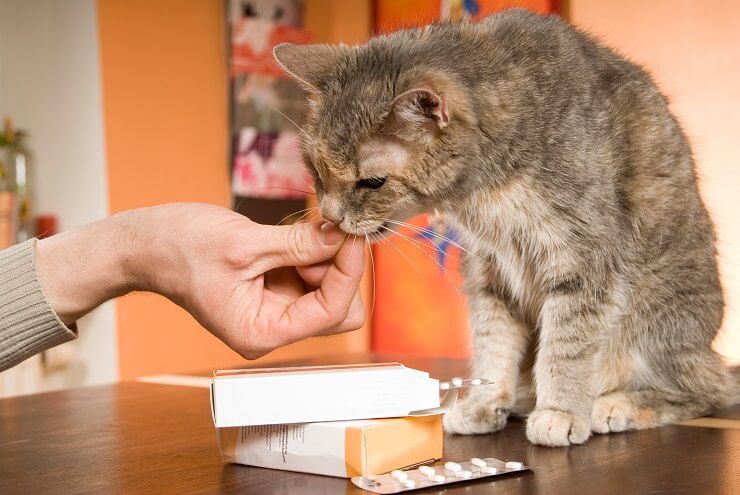
Clindamycin is an antibiotic that may be used in cats, especially in the cases of wounds, abscesses, or dental-associated infections like tooth root abscesses.
In this article, you’ll learn how clindamycin works, types of infections it is most often used for, potential side effects to monitor for, and some frequently asked questions.
Clindamycin For Cats Overview

About Clindamycin for Cats
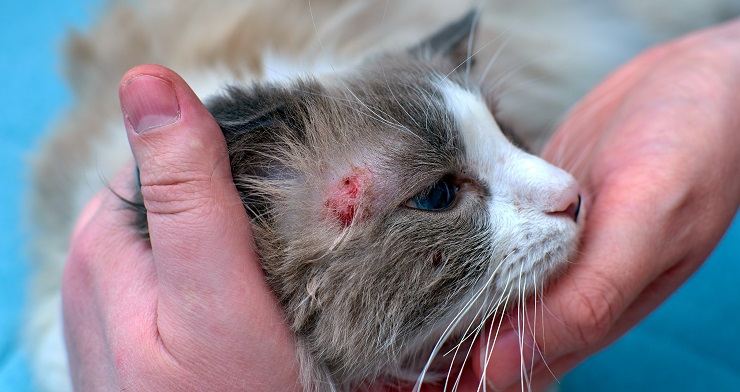
Clindamycin is a lincosamide antibiotic that has a fairly broad spectrum against certain types of bacteria. The brand name Antirobe Aquadrops manufactured by Zoetis is FDA-approved for use in cats for infections associated with wounds, abscesses, or dental disease.
While the capsule form of clindamycin is not FDA approved for cats, the capsules may be used in an off-label manner as well, especially the 25mg and 75mg capsules.
What Does Clindamycin Do for Cats?

As a lincosamide antibiotic, clindamycin may be either bactericidal or bacteriostatic, depending on the dosage and concentration of the drug at the intended site, and how susceptible the target bacteria are to it.
Although termed “bacteriostatic”, implying it only inhibits growth of bacteria, an antimicrobial acting as a bacteriostatic agent does actively kill bacteria. It simply requires a higher concentration than an antibiotic labeled as “bactericidal”.
Thus, for bacteria that are equally susceptible, clindamycin is not necessarily a “weaker” or “less effective” antibiotic when used as a bacteriostatic agent vs. bactericidal agent.
Clindamycin acts on bacteria by inhibiting protein synthesis of their cell wall.
Clindamycin has a broad range of effect against certain types of bacteria. This includes aerobic (oxygen dependent) round-shaped bacteria called cocci like Staphylococcus and Streptococcus.
Clindamycin also has a good effect against non-oxygen dependent bacteria, called anaerobes, which include Clostridium perfringens and Bacteroides fragilis.
All four of these bacterial strains may be found in dental infections in cats. Staph and Strep species of bacteria may also be found complicating surface wounds, while Clostridium and Bacteroides are found more in abscesses, such as those caused by the bite of another cat.
There is a whole host of bacteria called gram-negative bacteria, which clindamycin is not effective against. A second antibiotic would need to be used to help cover for these bacteria if appropriate.
Much of the time, veterinarians will determine the appropriate antibiotic to use based on the likelihood of susceptible bacteria in the area affected. However, there may be times when a culture and sensitivity is required to determine exactly what strains of bacteria are present and what type of antibiotic is most effective against them.
Although not labeled for it, clindamycin also has an effect against the protozoal organism Toxoplasma gondii, that causes toxoplasmosis. For those not familiar, this is the organism some cats may carry or shed in their stool, prompting human physicians to carefully council pregnant mothers to avoid contact with the litterbox.
When used to treat for toxoplasmosis, clindamycin may need to be used at higher doses. While it may suppress some infections, it may not completely clear the organism in all cases.
This is also why, if a pregnant person is in the home and toxoplasmosis is a concern, that testing a cat in the home for exposure and presence of toxoplasmosis first with blood testing may be preferred to generalized use of clindamycin in an otherwise healthy cat.
Side Effects of Clindamycin for Cats
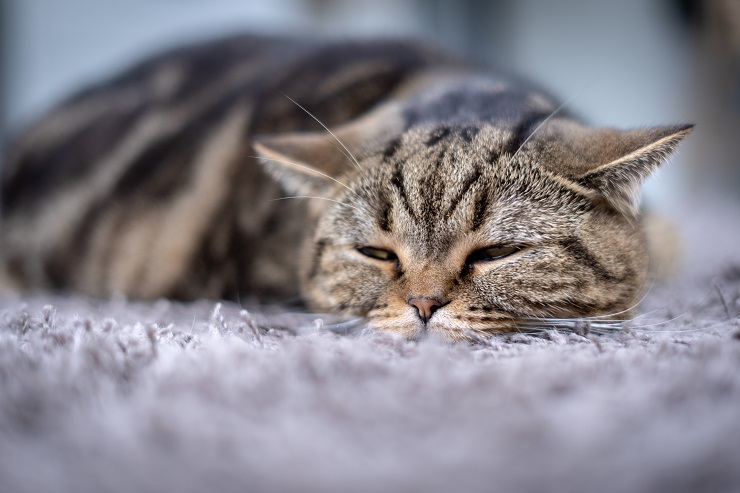
Apart from some cases, it appears that most cats tolerate clindamycin very well and show very limited signs of toxicity.
The most commonly reported side effects in cats include signs of gastrointestinal upset, like vomiting and soft stool.
Giving any antibiotic with food may help to offset some of these types of side effects. In studies involving cats specifically, use of pre and probiotics also helped to reduce these types of side effects.
There have also been reports in cats getting the capsule form of clindamycin developing signs of esophageal inflammation and something called an esophageal stricture.
A stricture in the esophagus is a narrowing of the tissue that makes it harder for ingested items to pass through. An esophageal stricture can occur secondary to irritation or ulceration of the tissues after scar tissue forms when those lesions heal.
Typically veterinarians don’t recommend “dry-pilling” cats, especially with certain medications including doxycycline and clindamcyin. These are best given in a treat designed to wrap around medication, like a Pill Pocket.
If dry-pilling must be used, it is often recommended to follow the medication with about 1ml of water dosed by a syringe to ensure the tablet or capsule doesn’t get stuck on the esophagus wall.
Using the liquid form of clindamycin (brands include Antirobe, ClinDrops, Clindacure, and others) will not contribute to stricture formation and can be a safer alternative form to use in this regard, as long as your kitty will tolerate a liquid medication.
The downside is that the common concentration of 25 milligrams per milliliter will call for at least 2 or more milliliters per dose for a 10-15 lb cat.
With some forms of clindamycin, cats may develop hypersalivation (drooling) or lip-smacking after dosing due to bitter taste.
Fortunately, it appears that most cats otherwise tolerate clindamycin very well. According to the manufacturer of Antirobe, cats dosed at 10x the dose for 15 days showed very limited signs of toxicity and this was also found for cats dosed at up to 5x the dose for 42 days.
If your kitty has any signs of kidney or liver impairment, clindamycin should be used cautiously. In severe cases, the dose may even need to be reduced.
If you ever have concerns about side effects or toxicity in your cat when using clindamycin, make sure to contact your veterinarian, the ASPCA Animal Poison Control Center (1-888-426-4435), or Pet Poison Helpline (1-855-764-7661) for further advice.
Clindamycin for Cats Dosage
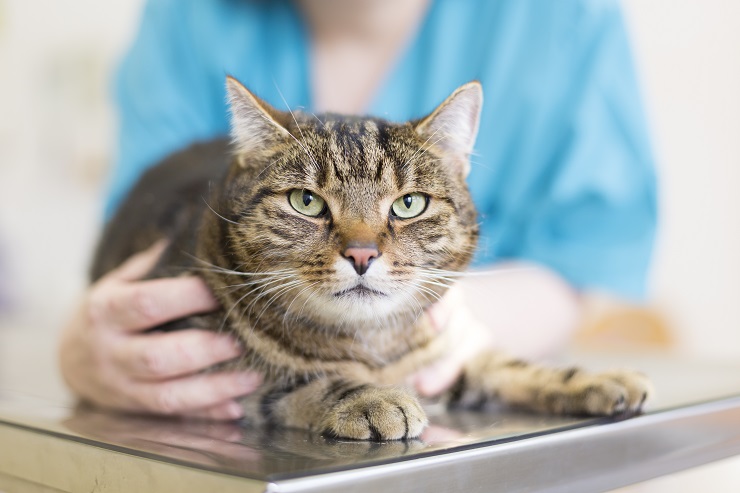
Whatever the case, it is extremely important to follow your veterinarian’s instructions completely and to always finish out the full course of an antibiotic.
The FDA-approved dosage for cats using Antirobe oral drops is 11-33 milligrams per kilogram every 24 hours, given by mouth. The maximum labeled treatment period is 14 days.
There are some cases where a veterinarian may choose a different, off-label protocol based on what is being treated. For example, it is common to treat for toxoplasmosis for 30 days.
How To Give a Cat Clindamycin

As with any antibiotic, use of clindamycin should only be under the care of a licensed veterinarian.
It is extremely important to follow your veterinarian’s instructions completely and to always finish out the full course of an antibiotic, even if your kitty appears to be doing or feeling better.
Stopping an antibiotic too early may increase the risk that bacteria may rebound and develop resistance to that antibiotic, making it ineffective.
Conclusion
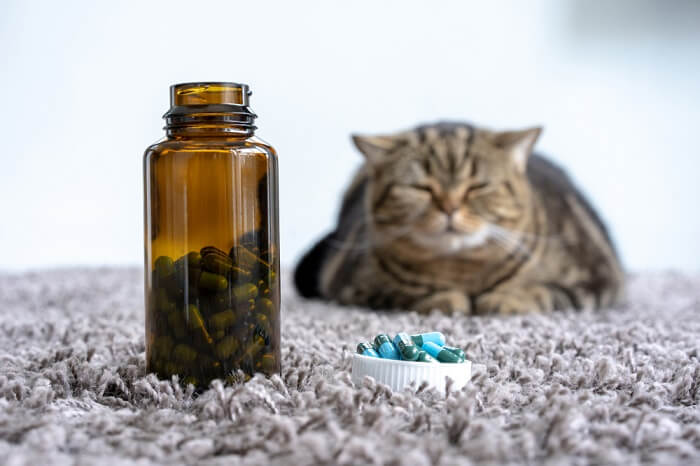
Clindamycin is a very useful antibiotic for cats, especially in the case of wounds, abscesses, or dental infections. Cats also tolerate it very well, though some may develop a mild gastrointestinal upset.
However, like all antibiotics, clindamycin cannot be used against all bacteria, and its indication for use needs to be restricted to a veterinarian’s discretion.
Drug Dosing Disclaimer: We are only able to provide doses for medications that are FDA approved for use in cats and only as the label guidelines dictate. For medications that are used off-label we can only provide guidelines and safety information for use. Safe and appropriate dosing for off-label medications can only be determined by a primary care veterinarian.
We encourage you to work with your veterinarian to determine if a particular medication is appropriate for your cat. Changing or adjusting a dose for your cat on your own without consulting with a veterinarian can carry risk. We do not encourage use of medications prescribed for human use in pets without first consulting with a primary care veterinarian.
Frequently Asked Questions
What is Clindamycin for Cats Used to Treat?
Primarily, clindamycin is most often used to treat wounds, abscesses like from cat bite wounds, and dental infections. It may also be used in some cases to treat some bacterial infections on the surface of the skin as well.
While not labeled for it, clindamycin also has effect against the protzoal organism Toxoplasma gondii. Toxoplasmosis can be transmissible to people, making it a zoonotic disease, and is the main reason human physicians caution pregnant women against coming in contact with a litter box.
While many cats with toxoplasmosis may only carry the organism and show no signs of disease, very young cats or those with a compromised immune system may develop signs of neurologic or ocular (eye) disease.
How Much Clindamycin Do You Give a Cat?
The labeled dose of Antirobe is 11-33 milligrams per kilogram every 24 hours. However, there may be some variations in dosing protocol depending on the disease being treated, so always make sure to closely follow a veterinarian’s guidelines and instructions.
Is Clindamycin Bad for Cats?
Clindamycin is not bad for cats at all, in fact cats tend to tolerate it very well. However, any antibiotic may cause signs of digestive upset.
Any antibiotic or other medication could be considered bad for a kitty if it is being used inappropriately or at an inappropriate dose. That’s why it’s very important to only give your cat clindamycin based on a veterinarian’s instructions.
Can You Give Your Cat Clindamycin?
While people may be prescribed clindamycin (typically capsules) themselves, it is important to never give your cat a medication prescribed for yourself. First, the dose prescribed for a person is going to be much higher than a dose prescribed for a cat and even one capsule prescribed for a person is likely to be too high a dose for a typical cat.
Second, the capsule form of clindamycin is accompanied by an increased risk of esophageal irritation and stricture (scarred narrowing of the esophagus) formation. A liquid form of clindamycin is available for cats through a veterinarian. If a pill or capsule is needed, your veterinarian can provide the best information on how to most safely administer this form to your cat.


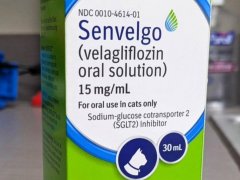




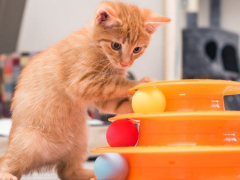
(Clindamycin)This medication can cause a lot of lethargy in a cat?
Hi Janett,
While I can’t be sure of what you’re calling “a lot” of lethargy, but in general I would say no. I have encountered pet owners who feel that their pet may be a little sluggish while on an antibiotic (though the reason is not really clear). If you’re seeing reduced appetite or any other gastrointestinal signs, we can see that with any antibiotic and may see lethargy related to that. I don’t know why your kitty is on clindamycin, but there’s also the thought process of what condition is being treated in my cat and is there any concern that condition is worsening despite being on a particular medication. I would certainly get in touch with your veterinarian’s office if you’re concerned your cat’s condition may be worsening despite therapy.
My cat had all of his teeth extracted and was given the antibiotic to avoid infection. I’m able to give him the medication at least once a day. He gets wise to me after the first time and doesn’t usually let me go in for another one. He won’t eat wet food so I can’t put it in anything. Before his surgery I told them how terrible he is with meds and they gave him and injection but told me to do my best to get as much into him as I can. I’m wondering if it would be okay to give him a larger once a day dose or if I’d be doing nothing by only giving it once a day.
Hi Jamie,
This is a good question. Clindamycin is FDA labeled to only be given once a day in cats. Clindamycin does tend to have a longer elimination half-life when higher doses are given (meaning the with higher doses, the medication will last longer). This is not the case with all antibiotics. I can’t advise on specific dosing for your cat, but if you’re able to convert your cat’s weight to kilograms (weight in lb divided by 2.2 if you know weight in lb), you can divide the milligram dose you’re giving of clindamycin by your cat’s weight to find out the mg/kg dose. The FDA approved mg/kg dose is included in the article, so you could see where the dosing sits. As long as you’re at 11mg/kg or higher, this should be sufficient for once a day dosing.
my cat was healthy and happy untilhe got a rabe shot and perscribed clindamycne, he died 10 days later, screaming i in pain and unable to breath, his lungs filled with fluid and became incapassitated. after the second dose of clinda. 8 hrs he suffered befor dying on my way back to the vet .
Hi Natalie, I’m so sorry to hear about your kitty. However, I don’t feel clindamycin would have directly caused the effects you’re describing. If your cat was prescribed clindamycin, there must have been some illness your veterinarian was concerned about they were trying to treat. It very likely progressed despite attempts at therapy. It continues to baffle me how they manage, but I have seen many cats cope with medical conditions and appear very normal on the outside for some time, until they suddenly go into a crisis. This is especially true with health conditions causing fluid build up in or around the lungs. Even if they’ve been building up for days or weeks unseen, such conditions can appear to develop very suddenly and can be very traumatic to experience when they reach a critical stage. I’m sorry for your loss.
My cat has advanced dental disease/infection. I cannot afford to get the surgery or have him put to sleep and it is killing me mentally A friend gave me a human prescription of clindamycin 300 mg. Wondering if I can split the capsules into the right amount for his body weight, add to water or chicken broth and give it to him in an oral syringe. If someone who knows can help ASAP, would appreciate it. Thanks, Josh
Hi Monique, I can certainly sympathize with your situation. As a doctor, I can’t give you specific advice because what you’re talking about doing is essentially compounding a medication at home and our medical license doesn’t cover that. But for an average 10lb cat, the labeled dosage range for clindamycin for dental infections is about 50-150mg every 24 hours.
I have a 13 year old female cat who had an unknown infection that was only evident once an abscess appeared on her hind leg. We got her to the vet who put a drain in the abscess and prescribed antibiotics, but she only seemed to get worse and worse. The wound began to turn black (necrotic) and we went back and had a culture taken from the infection area and based on those test results the medicine was changed to clindamycin for the particular bacteria that was identified, (but that took ANOTHER week to receive the results for) In the meantime she stopped eating and dropped a significant amount of weight. My question is, she was on another medication for nearly two weeks as this infection grew worse and worse. She now has a hole in the side of her leg the size of a quarter and has not eaten on her own in over 10 days. We have been syringe feeding baby food (chicken) with vita-cal mixed to just get something in her body and she’s been keeping it down, but she dry heaves and gags at even the smell of any other food. Any idea when the clindamycin should start to affect her ability to eat or show some kind of positive results on the infection once it’s started being administered or has it been too long for her to bounce back from this?
I’m sorry to hear this is going on with your kitty. I think that the way this was approached was fairly conventional. In a majority of cases a bite wound abscess will heal with the aid of most broad-spectrum antibiotics. Placing a drain is also an appropriate step depending on how big of an abscess is present.
It sounds like unfortunately, one or more bacteria involved in this wound were resistant to other broad-spectrum antibiotics. You can’t predict initially whether this will be the case or not. Bacterial cultures do take a couple of days to determine initial growth and another couple of days to determine antibiotic sensitivity and there’s not much you can do about the timing. Cultures are sometimes collected immediately with some wounds but they are an added expense. Often the course of action pursued is empirical antibiotic therapy and a culture will be pursued if the response is not as expected and a wound does not heal within 10-14 days..
The necrosis of the wound definitely complicates things. The infection may be controlled with the clindamycin, but it sounds like you have significant tissue damage that needs to heal and this process can take several weeks. Referral to a surgical specialist may provide some additional options to help with healing like a tissue graft.
It may also be appropriate to consider biopsy of the wound tissue to ensure this wound did not develop from a cancerous cause. If verified to not be a cancerous cause, cold therapy laser has also demonstrated benefit in accelerating wound healing.
Thank you so much for your reply. We actually had to euthanize her just this afternoon. The infection began to clear but the damage had been done and her organs began to fail. She could barely walk and refused to eat. She went very quickly and peacefully. We’re heartbroken. My advice to anyone reading this is to get a culture as soon as possible. Had we known clindamycin was what she needed to battle this particular bacteria in the begining many precious weeks could have been saved and perhaps we would have had a different outcome.
Hi Mandy,
I’m so sorry to hear that.
It’s hard to say when a wound necroses like that so quickly if a lone antibiotic will make the difference or not. But I agree we need to find a way to make bacterial cultures a more regular and accessible practice.
I am actually looking for information on clindamycin phosphate LOTION and I can’t seem to find anything online about that. My cat has an infection on her neck area, so I put some lotion on the area. I didn’t think she could like it off in that area, but she seemed to be able to. Today she was throwing up and pooped on the floor. I know I found info online at one point about how it wouldn’t hurt them appreciably, but I can’t find it tonight. Can you enlighten me? I am really worried….
Hi there! I apologize for the late reply. I would recommend talking with your veterinarian about what happened, just to make sure you get a professional’s assessment. You can also contact the A.S.P.C.A.’s Animal Poison Control Center at 888.426.4435.
Hi Pamela,
Thanks for your question.
Clindamycin topical products are used uncommonly in pets, at least in my experience, but they can be used. Some veterinary dermatologists have advised using topical clindamycin only if other topical products we use more often don’t work well.
However, there should not be any really significant safety concerns with topical clindamycin any more than there would be with oral clindamycin.
But it’s important to realize that any antibiotic can cause digestive upset. Also for cats, if they lick a topical product off their skin, they can have an adverse taste response. Many topical lotions aren’t designed to taste very good and they don’t. And yet, cats can’t help but groom themselves of anything on their fur.
This latter may be more of what you saw, but if any signs of digestive upset or poor appetite linger through your cat’s next mealtime, I would consider a veterinary exam.
I noticed Clinda drops have a shelf life of 2 weeks What about an unopened bottle.
Hi Bill,
I do know the shelf life of an unopened, sealed bottle is considerably longer just based on the presence of stock in my own clinic, though I don’t know specifically off-hand. The easiest answer is that the expiration date on the packaging would specifically provide that information. Practically, this can always depend on when the stock is delivered too.
Thanking you with all my heart for getting back to me. Sophie’s diagnosis is Toxoplasmosis and her count was something like….. 13,000.00. I am sick to my stomach about this. I live in a condo and have been here 29 years and have NEVER seen a mouse. Sophie is 13 years old but until this, which came on her all of a sudden when her back legs would not work, she has really never been sick. She leads a damn good life with all my other pets do and have done…. just lazy bums who run this house. I just want to get rid of that bacteria in her little body.
Hello Doctor,
Please, HELP ME !!!! My cat, Sophie, desparately needs INJECTABLE Clindomycin. I am doing this on my own but my veterinarian cannot locate the injectable anywhere. Why ??? What I am confused about is the fact that it is almost impossible to get any injectable Clindomycin. The tablets and pills are thrown up immediately. As for the liquid with the baby dropper, she vomits that up as soon as I give it to her. If you have this, I will call my vet ASAP and she could call it in. This way I can take Sophie to her pet hospital and get her shots because we are just about one mile apart. Hoping you can help and I thank you kindly.
Hi Debbie,
I’m sorry to hear you and your kitty are having a difficult time.
In my experience, injectable clindamycin is not a common item that most veterinary general practices carry. It is rarely needed and requires a slow intravenous infusion that can only be done under veterinary personnel care. There may be some referral/specialty hospitals, universities, etc. that keep it in stock. Hopefully, there are some in your area you could try to touch base with.
The only place many injectable antibiotics can be ordered from is a medical supply company with which you have to have an established account. I couldn’t say for sure, but if your veterinarian’s medical supply company does not have it in stock, there may be a shortage or backorder which unfortunately happens a lot now with a variety of medical supplies.
I’m not clear why your cat requires injectable clindamycin only, as there are often other alternative antibiotics for most conditions. If toxoplasmosis is suspected, it’s important to be certain of the diagnosis. There are some alternative treatment choices besides clindamycin, which you and your veterinarian could consider.
If it is simply that your kitty’s stomach cannot hold it down, antiemetics like Cerenia can sometimes be used in advance of administration to keep it from coming back up.
My cat has severe kidney disease and has abscess on back gums.. trying to keep her comfortable I asked our vet for the abscess. They gave her clindamycin 2 MG twice a day. I read it should be used cautiously in cats with kidney disease. Hope this isn’t worsening her condition.
Hi Pat, lincosamide antibiotics should be used cautiously in pets with severe kidney disease (and liver disease) but this doesn’t mean they’re completely contraindicated. Clindamycin is excreted partially through the urine and that is the reason why it should be used cautiously if the kidneys aren’t working well. My understanding at least isn’t so much that it is toxic to the kidneys as it just will not be cleared from the body as efficiently. Unfortunately in pets with severe kidney or liver disease, drug options become more difficult as both of these organs are responsible for clearing drugs from the body. Clindamycin is usually a great antibiotic choice for dental disease but depending on how advanced your kitty’s kidney disease is, it’s important to discuss frequent monitoring of kidney values, especially after starting any new medications.
My cat has severe kidney disease and has some abscess on gums of back teeth. Trying to keep her comfortable I asked for something for the abscess. They gave me liquid clindamycin 2 MG twice daily.. Read that it should be used cautiously in cats with kidney disease. Hope this isn’t worsening her condition.
Hi Lydia, the commercial clindamycin oral solution can be a pain. Another option is to look into compounding through a compounding pharmacy, especially if your cat is due to be on clindamycin for a few weeks. Compounding options can include a higher concentration so that you’re giving a smaller volume each time, more tasty flavoring added to the liquid, or having dose-appropriate tablets or chews made.
Good information, but how do I give it to my cat without holding her down and squirting the liquid down her throat?
Good question, Lydia! You could try mixing it with a small amount of wet food (about a tablespoon). Try something special your cat will be eager to eat and reserve it only for administering the Clindamycin so she doesn’t lose interest.
Great information—relieved my anxiety. My kitty, per vet’s instructions, on 75mg twice daily for dental disease. She has oral Squamous of jaw bone so no dental surgery. I’ve been reading what I can find about clindamycin but this article explained everything. The drug has helped her infection and bad breath. Thank you so much!
Happy to hear that this article relieved your anxiety, Cindy. Thank you for sharing your experience.